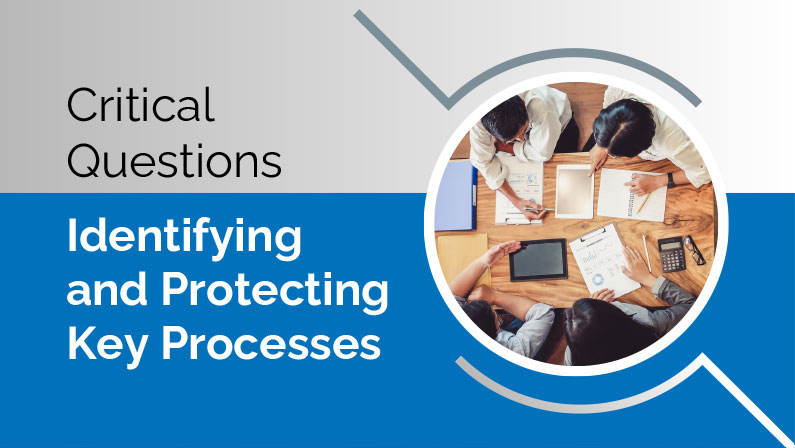What Are Your Most Critical Processes? At the core of every organization are its key revenue-generating processes. These need to be identified first. What enables your business to function on a daily basis? Understanding the full scope of these processes—how they flow, who is involved, and where potential single points of failure lie—is the cornerstone of effective protection.
This exploration should not stop at identifying what these processes are but should extend to how data flows within and outside of the organization. For instance, a retail business may have a critical sales process that involves customer purchases, inventory management, and shipping logistics. In this scenario, the flow of customer data—such as payment details and delivery information—becomes paramount. Ask: Who touches this data? In the case of a retail business, data may pass through various departments including customer service, finance, and fulfillment teams. Third-party vendors (supply chain), such as payment processors or shipping partners, may also access this data.
How does it move? Data may be captured at the point of sale, transmitted to backend databases, and shared with third-party logistics companies for order fulfillment. The movement of this data across multiple systems—each with its own security protocols—creates potential vulnerabilities. For example, an insecure API connection between your system and a third-party provider could expose sensitive information, leading to data breaches.
Where does it rest? It’s essential to understand where data is stored, both temporarily and long-term. In our retail example, customer data might rest in a cloud-based CRM system, on an internal server, or even in a third-party warehouse management system. Each of these storage points has different security requirements. If sensitive payment data is stored on a server that lacks encryption or proper access controls, it becomes a prime target for attackers.
What are the failure points that could disrupt this flow? Potential disruptions could occur at various stages of the data lifecycle. For instance:
- Internal mishandling: A lack of proper access controls could result in unauthorized employees accessing customer data, increasing the risk of data loss or internal breaches.
- Third-party vulnerabilities: If a payment processor has weaker security measures, a breach at their end could expose your customers’ payment data, even though your internal systems are secure.
- Infrastructure failures: Outdated servers or reliance on a single cloud provider without backups could lead to disruptions, whether due to a cyberattack or an operational failure.
By carefully examining each stage of the data flow—who touches it, how it moves, where it rests, and where the vulnerabilities lie—you create a more holistic view of your organization’s risk profile. This level of understanding enables you to implement more targeted and effective security measures, ensuring the resilience of your key processes.
How Aligned Are Your Tech and Business Functions?
Once you’ve gained a thorough understanding of your critical processes and data flow, the next step is ensuring that your technology and business functions are properly aligned. Alignment here means that the technical resources and solutions you employ are designed to directly support your organization’s strategic goals, rather than merely being reactive to potential threats.
Gaps in alignment often lead to vulnerabilities. For example, if your IT team is focused on securing servers without considering the critical business process that relies on cloud access for customer orders, there’s a gap. Addressing these gaps requires more than just deploying additional technical tools—it calls for a business-driven approach that connects technology to tangible business outcomes. This is where the Business Impact Analysis (BIA) becomes essential.
A BIA is a systematic method that examines all functional areas of the organization to identify risks and assess their potential impacts on business operations. It involves asking key questions such as:
- What processes are most critical to generating revenue?
- How would disruptions to these processes affect the organization’s ability to operate?
- What level of protection is needed to ensure these processes remain functional even in adverse scenarios?
The BIA helps organizations preemptively identify risks before they materialize. It focuses on anticipating how various scenarios—whether cyberattacks, operational disruptions, or system failures—could impact business functions. From there, the organization is able to prioritize protective measures where they matter most.
By using a BIA to map out these risks, organizations are able to align their technical capabilities with their core business objectives, reducing vulnerabilities at critical points and ensuring a smoother, more secure operation. This proactive approach not only safeguards key processes but also ensures that technology investments are made strategically, aligning with the broader goal of protecting revenue and reputation.
Mitigation: Building Resilience
Once an organization has identified risks, the focus must shift to adding layers of protection and increasing resilience. The goal is to ensure that not only are your money-generating processes secure, but they can also withstand and recover from disruptions. This involves more than just securing individual components; it means looking holistically at processes and building redundancy to mitigate single points of failure.
Streamlining processes for better security and performance improvement will simultaneously improve security and operational efficiency. For instance, in an e-commerce business, automating routine tasks, like data backup or security patch updates, will reduce the chances of human error, while also freeing up resources, for more strategic activities. Similarly, leveraging automation for security monitoring—such as using AI-driven threat detection—will ensure that potential issues are flagged and addressed in real-time, rather than waiting for human intervention after the fact.
Automation also plays a key role in reducing response times during incidents. By having systems in place that automatically detect, quarantine, and mitigate threats, organizations are able to prevent small issues from snowballing into major disruptions. These automated responses are able to be integrated into broader Incident Response (IR) and Business Continuity (BC) plans, ensuring that responses are swift, coordinated, and effective.
Are Your Processes Adequately Protected? Organizations need to continually ask: are these money-generating processes protected at every stage? Take, for example, a financial services organization whose revenue depends on real-time access to market data. If the system providing this data is vulnerable to cyberattacks or has a single point of failure—like an unprotected data transfer link—then the organization’s ability to function may well be compromised.
Mitigation strategies for these scenarios often involve adding redundancy and multi-layered security. For example:
- Data redundancy: Implementing mirrored databases across geographically dispersed data centers ensures that if one fails, or is compromised, operations will continue seamlessly from another location.
- Network redundancy: Creating multiple, independent pathways for data transmission means that if one route is compromised, others remain available, preventing full disruption.
- Layered security measures: Employing multi-factor authentication (MFA), encryption at rest and in transit, and frequent security audits builds layers of defense that make it increasingly difficult for threats to break through.
By addressing these layers, organizations not only secure their processes but also build resiliency—the ability to continue operating, despite unexpected disruptions.
Building redundancy to avoid single points of failure is a key component of resiliency. It means creating backup systems, and redundant processes and protocols, which are able to take over when primary systems fail. This approach applies not only to technology; but also applies to people and processes. For instance, in critical financial operations, having key employees cross-trained, ensures that knowledge isn’t siloed with one individual. If an employee is unavailable during a critical event, others are able to step in, without hesitation.
In terms of technology, redundancy might include backup servers, alternative communication channels, or secondary cloud providers. Best practices outline regular testing to ensure that systems will function, as expected, when needed. For example, many organizations conduct disaster recovery simulations, where they intentionally take key systems offline, to see how effectively backup systems and teams are able to sustain operations.
Mitigation in Action: A practical example: consider a healthcare organization, which relies on electronic health records (EHRs) for patient care. If the EHR system goes down due to a cyberattack or system failure, the consequences will probably be dire, affecting patient safety and compliance with healthcare regulations. In this case, building redundancy means not only having backup servers, but also having manual processes (like paper records), which may be activated in emergency scenarios. It’s about ensuring that business-critical systems are protected, but also having fallback mechanisms in place, which staff may implement, without disruption to patient care.
By asking and answering these critical questions, organizations are able to move from a reactive stance to a proactive one. Building layers of protection, adding redundancy, and regularly testing for resiliency, ensures that their processes are not just secure, but adaptable and robust, against potential disruptions. In doing so, they mitigate risks and build a security posture that is not only protective but dynamic, allowing the organization to stay ahead, in an ever-evolving threat landscape.
Read here on more tips on protecting your organization’s revenue and reputation





